The Surprising Link Between Herpes and Shingles

The younger you are, the more likely it is you've never heard of shingles. And this isn't surprising because shingles tends to be an older person's disease.
However, shingles is the unwelcome return of a condition many of us get as kids—the crazily-itching chickenpox! The virus responsible for chickenpox stays dormant in your body and the bug doesn't erupt again until we hit age 50 or older—but it can happen at even younger ages.
So what's this information got to do with herpes, you're thinking? Well, it all depends on what version of the word "herpes" you're using.
All about viruses
The word "virus" applies three different ways when you're talking herpes and shingles, and two of them can be easily confused:
- Shingles—The clinical name for shingles is the herpes zoster virus, which is specifically caused by the varicella-zoster virus (VZV). It tends to present as a blistery set of stripes on one side of your body.
- Herpes—The clinical name is herpes simplex virus (HSV). There are two different versions, and experts will tell you both mimic herpes zoster, which can be problematic when it comes to an accurate diagnosis:
- Oral herpes is caused by the herpes simplex virus 1 (HSV1), and symptoms usually present as fever blisters on your lips and around your mouth, although they can also appear on your tongue. About 50-80 percent of Americans will experience cold sores at some point in their lives, making HSV1 the most common form of herpes.
- Genital herpes is caused by both HSV1 and a variation known as herpes simplex virus 2 (HSV2), presenting as sores on the penis, vagina, anus and buttocks.
Spreading things around
Any virus can be spread to others—but it's how the virus spreads that provides important clues on how to avoid it.
Both types of herpes simplex—oral or genital—are spread through personal physical contact. Either can be passed through intimate relations, but HSV1 can be passed through kissing: a cold sore on your partner's lips should be a warning sign.
Regardless of how it's passed, herpes simplex is classified as a sexually transmitted disease (STD) and, whatever your gender, the more sexually active you are the greater your risk. For some reason, though, females are most often infected by HSV2.
In comparison, shingles has a different transmission process. You can't catch shingles from someone but if you've never had chickenpox before, you can catch that. Transmission happens if the person you're with has shingles blisters that have broken open and if the resulting fluid winds up on someplace open on you, such as a cut.
Preventive measures…and not only for you
The vaccination for preventing shingles has been around for close to a decade. It's especially recommended for anyone age 60 and older who had chickenpox as youngsters.
If someone you know already has shingles, remind them to cover their rashes and watch out for open sores. To increase safety, regularly wash their hands carefully. Calamine lotion and even oatmeal baths can fight the itching, while drugstore pain relievers—aspirin, acetaminophen and ibuprofen—can relieve pain.
There is no vaccine available to prevent herpes, but you can take meds to treat and shorten the length of outbreaks. The most important actions you can take are to prevent transmission. Cleanliness and safe sex are both major preventive measures, even when the virus is dormant.
Condoms are critical protection, but most important of all is honesty—that is, knowing your partners' sexual history, revealing your own and making sure no one's hiding any blisters. Of course, none of this is a guarantee as it is very possible someone could have herpes simplex without presenting any symptoms.
If you know you have herpes or shingles, be especially careful of any physical contact with pregnant women or anyone you know who has a weakened immune system.
Your doctor is a critically important ally in your battle against herpes and shingles. Get a professional diagnosis, the antiviral medicines you'll need for treatment and make sure you ask all the questions to keep yourself and others protected while breakouts are visible and dormant.

















